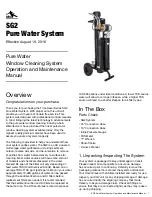
1
1
0
0
1
1
0
0
''1''
''0''
Fig. 13:
Gas ballast valve, standard version
Open gas ballast valve
► Rotate gas ballast valve to the left to open, into position “
1
”.
Close gas ballast valve
► Rotate gas ballast valve to the right to close, into position “
0
”.
6.3.2 Gas ballast valve with flushing gas connection
NOTICE
Risk of damage from unacceptably high flushing gas pressure
Increased flushing gas pressure compromises the operational reliability of the vacuum pump, and
causes increases in power input and operating temperature.
► Observe the maximum permissible flushing gas pressure of
1,500 hPa (absolute)
.
► Dose the flushing gas quantity with the dosing screw on the gas ballast valve or on site.
Flushing gas valve installation is optional.
For some processes, Pfeiffer Vacuum recommends the addition of flushing gas to dilute the process
gas, and prevent condensation in the vacuum pump.
1
Fig. 14:
Gas ballast valve with flushing gas connection
1 Flushing gas connection (M 5) with elbow union
Required tool
● Open-end wrench,
WAF 7
Closing the gas ballast valve
1. Screw elbow union into flushing gas connection.
2. Connect hose (DN 5 mm) to flushing gas connection, or utilize threaded connector directly.
3. Select type and quantity of the flushing gas utilized according to process.
4. Consult Pfeiffer Vacuum if necessary.
Operation
31/60
















































